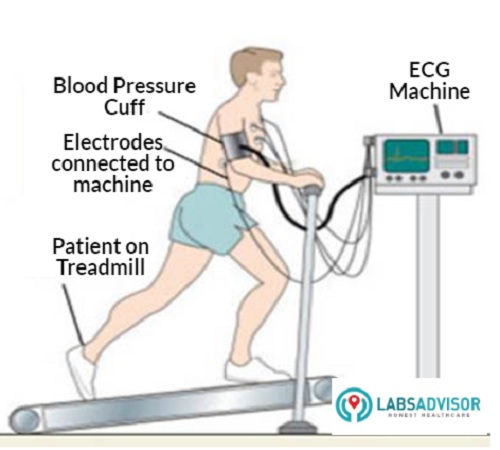Cardiac Stress Test or Treadmill Test (TMT)
Cardiac stress test or Treadmill test (TMT) is done to evaluate how your heart responds when you are made to exercise in a controlled environment. It is most commonly known as the TMT test.
Purpose of Treadmill Test (TMT)
The treadmill test or TMT test determines the effect of physical stress on your heart. It is done to see how well your heart responds when you are made to exercise in a controlled environment. It is performed on an OPD basis so there is no need for hospitalization for the test.
Patient exercises on a treadmill under the supervision of a physician and his/her ECG are monitored continuously. In addition, blood pressure and other symptoms are also monitored. ECG changes detected during stress test can lead to the diagnosis of Coronary Artery Disease (CAD).
Coronary Artery Disease (CAD) is the most common type of heart disease affecting millions in India. It can lead to angina and heart attack. It is the leading cause of death in both men and women. TMT is a safe and cost-effective test that indicates the presence of the disease.
Preparation for TMT Test
Before undergoing a TMT test, you should tell your doctor in advance if you
- Get chest pains and shortness of breath while walking or running.
- Have stiff joints from arthritis.
- Have exercise-induced Asthma. I.e. you get wheezing or cough while exercising. Your doctor will advise accordingly.
The following are the recommendations to follow on the day of the test:
- Do not eat or drink for three hours prior to the procedure. This reduces the chances of nausea that may happen due to strenuous exercise after a heavy meal.
- Specific heart medicines may need to be stopped one or two days before the test. Such instructions are generally provided when you are scheduled for the test.
- Wear comfortable clothes and shoes that are suitable for exercise.
- Information regarding the test will be given to you to read and you may be asked to sign a consent form.
- You should keep approximately one hour for the entire test, including the preparation.
The procedure of TMT Test
For a regular stress test, the equipment used is a treadmill, though in some labs the stress test is conducted using a stationary bicycle. This equipment also has connections to the ECG monitor and a paper recorder, as well as a blood pressure cuff. Though the dangers of cardiac arrest during TMT tests are extremely low, as the test is conducted on patients who are suspected to have a heart condition, almost all labs are ready with emergency medication and resuscitative mechanisms.
A stress test generally takes up to 60 minutes from beginning to end. The actual exercising part of the test takes only 20 minutes. You will be brought to the test room where the technician or nurse will record your heart rate and blood pressure at rest. She will then place sticky patches that are the electrodes on your chest.
These patches are attached to wires that carry the electrical activity of the heart to the monitor and recorder of the ECG machine. Before the start of the test, the ECG will record your heart activity on paper. This is what is known as the Resting ECG. More recordings will be made during the test when you are exercising on the treadmill.

The treadmill is switched on at a rather slow, also called ‘warm-up’ speed and gradually the incline of the treadmill is increased. This is a pre-set program, which regulates the speed and incline of the treadmill over time intervals. Every three-minute interval is called a stage. During the test, your blood pressure will be recorded at every stage, but the recordings can be done more frequently if necessary.
Measurements taken during and immediately after the workout are indicators of cardiovascular fitness and how well your autonomic nervous system is functioning: how long you can continue at the treadmill’s speed and incline gradually increase; whether your blood pressure drops instead of rising; whether the heart rate increases to a level appropriate for your age and how fast it recovers when the test ends; and whether the pumping chambers of the heart develop any abnormal beats.
Your ECG is recorded both on paper and on the monitor. If you develop any sort of uneasiness, the test could be stopped before the target heart rate is achieved. Otherwise once the test has been completed, the treadmill speed and incline is gradually decreased to cool you down and then finally stopped.
You may feel a little bit of tired after the test but that is normal as body muscles were put to strenuous work.

No comments:
Post a Comment